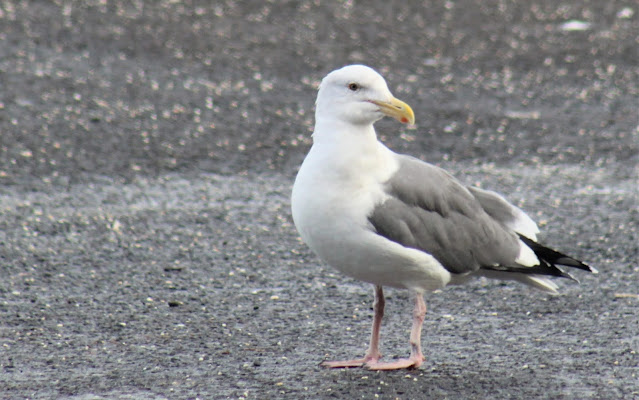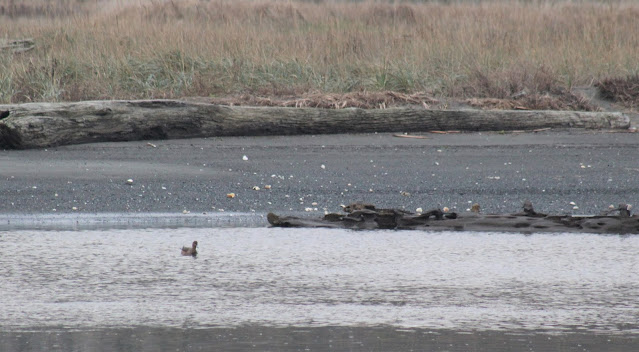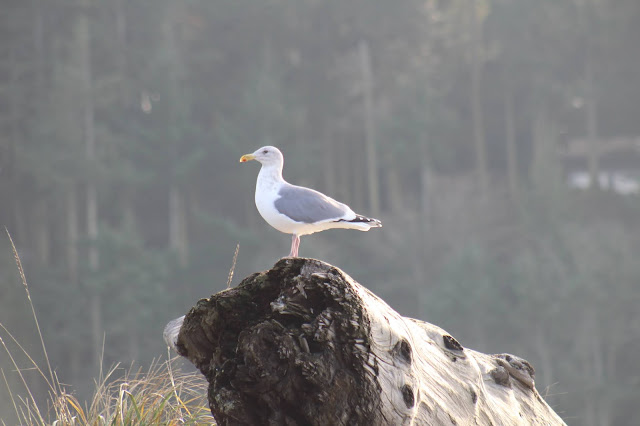Today, about 20 birders arrived for the weekly Wednesday
bird walk at Nisqually National Wildlife Refuge on a morning in the
mid-40s. We had a mostly dry session,
with some intermittent light drizzle. I
have made an effort to attend this birding venue as often as I can when I’m not
roaming around the country. Good people, and Good Birding.
The pond levels in the Puget Trough continue to rise with the late fall rains, and there are a lot of waterfowl to be seen here at the Refuge.
Most of the waterfowl we see are geese or “dabbling” ducks. The dabblers are the field and surface-feeding birds, rather than “diving” ducks.
We tend to see the diving ducks in the deeper waters along the McAllister Creek estuary, in the deeper ponds, or in the Nisqually River itself, where foraging opportunities are better for those species.
The tide was at 11 a.m., but it was only a +7.7-foot low water. So, while we had a lot of mud when we first arrived at the north dike and estuary, the tide flooded pretty quickly toward a 13.3-foot high.
When the tide is most of the way in, the water pushes the waterfowl and shorebirds ‘inland’, which allows us Birders closer views of birds that otherwise would have remained ‘way out on the flats.
The Refuge removed the old outer dike about a dozen years ago, to restore the estuary and improve habitat for ESA-threatened Chinook salmon. Many of the trees that had grown behind the previous dike have died and provide perches for birds of prey. It often takes a view through a spotting scope (or large camera lens) to get identification on birds that are over ¼ mile away.
Here, the birds are seen to be a pair of Peregrine Falcons. Nowadays, we see several birds of this species throughout the winter, and have to remember that these birds suffered badly from eggshell thinning, and that they (and we) benefit from the 1972 ban on the use of DDT pesticides in the United States (Thank you, Richard Nixon…) and subsequent restoration efforts.
Hundreds of gulls use the Refuge’s estuaries, tidal
marshes and river banks. It is a
challenge here, in the heart of the “Olympic Gull” distribution, to sort
through the large, pink-footed gulls.
Puget Sound’s resident and wintering gulls are mostly hybrids between
Glaucous-winged and Western Gulls. Individual
birds run the gamut in their physical characteristics between the two taxa.
Visitors to our region from “away" often wish to ‘twitch’ a Western or Glaucous-winged Gull on their Life Lists, and are disappointed to find that there are few ‘pure’ birds to be found. On the other hand, ‘Gulling’ here can certainly sharpen one’s skills. The birds in the photo above show the muddy heads characteristic of winter-plumaged Glaucous-winged Gulls, but have much darker grey mantles and not-quite-black wing-tips that would be expected in a ‘pure’ Western Gull. “Just” hybrids . . .
Thank Goodness, the Ring-billed Gulls are rarely hybridized with other species, and are easily identified by the black ring near the tip of their bill.
You would think that the chill mist and showers would keep the passerine activity to a minimum, but we saw over 60 species total, and the passerines gave a good show. The locally-wintering “Sooty” Fox Sparrows gave us especially good views. Our coastal Fox Sparrows are dark chocolate brown, rather than having the reddish plumage that the “foxy” eastern subspecies have.
The Anna’s Hummingbirds were also showing off. Forty years ago, seeing a hummingbird in the winter would have been unheard-of. But, with the warming of the climate over the past several years, this species has expanded its range north from its ‘stronghold’ in California, into the Willamette Valley in the 1970s, the Puget Trough in the 1980s, and is now not that uncommon in the lower mainland of British Columbia and all the way to Alaska!
Our local Song Sparrows are likewise much darker than their inland and eastern conspecifics. Besides our resident nesting birds, we also see wintering birds from the more northern coastal subspecies. One of these days, I will make an effort to see if I can tell the several races apart.
The Refuge Volunteers lead a bird walk every Wednesday, meeting at 8 a.m. at the Visitors’ Center. Come join us if you get the opportunity!
Nisqually NWR eBird checklist is Here

















































